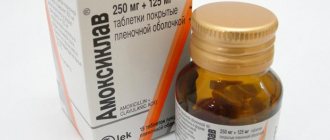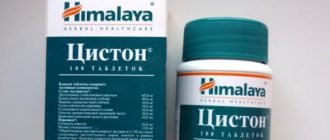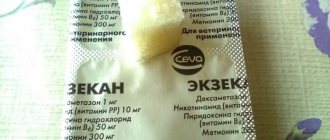Home » Useful Information
Allergic reactions are not uncommon in cats. Such pathologies provoke a number of unpleasant symptoms, including itching and skin rashes, which can be treated with antihistamines. You can use such medications only after reading the instructions and eliminating contraindications.
- 2 Types of antihistamines
2.1 Drugs of different generations - photo gallery
- 3.1 Medicines used to treat pets - photo gallery
Mechanism and signs of an allergic reaction
When an allergen enters a cat’s body, the immune system recognizes it as a foreign and dangerous substance. At the same time, histamine enters the blood. This substance interacts with cell receptors and causes allergy symptoms. Antihistamines for cats relieve these symptoms.
How can you tell if an animal is having a negative reaction to an irritating substance? This can be determined by the following signs:
- The skin under the fur turns red, and a rash in the form of spots can be noticed.
- The skin on the pads of the paws peels, and ulcers appear in the areas between the toes.
- The animal is constantly itching, and areas of baldness are noticeable.
- Dyspeptic symptoms such as nausea, vomiting and diarrhea are observed.
- It becomes difficult for the cat to breathe.
- There is a clear discharge coming from the nasal openings, like a runny nose.
Signs of an allergy depend on the type of substance that caused the negative reaction. For example, with food intolerance, dyspeptic symptoms are more common, and with insect bites, the animal is bothered by itching and manifestations of dermatitis. Symptoms can appear either immediately after contact with the allergen or after some time. Because of this, an allergic reaction can sometimes be difficult to detect.
Folk remedies
Traditional healers know many good time-tested recipes. However, dosages should not be abused:
- honeycomb (top part), 1 tsp. eat in pure form, washed down with water or added to food;
- chop birch buds (20 g), pour boiling water (500 l), leave, bring to a boil, take 0.5 cups, after filtering;
- celery, squeeze out the juice (20 ml), take 3 times a day as an infusion or steam 2 tbsp. boiling water;
- Finely chop motherwort (15 g), pour boiling water (0.5 l) over the country, leave, gargle or rinse nose. Can be added to water and bathed for pets.
List of drugs
The list of antihistamines for allergies for cats is quite extensive. It includes both old proven remedies and new generation medicines. Their principle of action is based on blocking histamine-sensitive receptors. Veterinary medicine uses the same medications that treat allergic reactions in humans. However, there are some differences in treatment. When asked what antihistamines can be given to cats, veterinarians answer that animals should not take H2 receptor blockers. These drugs work well for people, but for cats their use is pointless, they are ineffective. Pets should only be given H1 blockers.
A quick overview of antihistamines for cats typically includes three generations of medications. These drugs differ in their effect on the body and the presence of side effects. 1st generation medications do not last long, so a high dosage is required. The disadvantages of these drugs include their effect on the central nervous system. The animal becomes lethargic and drowsy. These medications include:
- "Suprastin";
- "Diphenhydramine";
- "Diazolin";
- "Tavegil";
- "Pipolfen."
2nd generation drugs do not cause severe sedation, but have a negative effect on the heart. This group of drugs includes the following:
- "Fenistil";
- "Loratadine";
- "Kestin."
3rd generation drugs do not have many of the disadvantages that are characteristic of older drugs. They act over a long period, which allows you to prescribe a lower dosage, and do not affect the nervous system. Of the 3rd generation medications, two medications are used in veterinary medicine:
- "Cetirizine" ("Zyrtec");
- "Fexofenadine."
When choosing the right drug for your pet, you need to consult a veterinarian. Only a specialist can correctly prescribe medicine; it is impossible to cure an animal of allergies on your own.
Below is a more detailed review of antihistamines for cats.
First generation drugs
These remedies last about 5-6 hours. Because of this, they must be given to the animal at least 2-3 times a day. The dosage of antihistamines for cats is determined by a veterinarian. The amount of medicine depends on the weight of the pet.
As mentioned above, 1st generation drugs have a hypnotic and sedative effect. For this reason, some cat owners give such remedies to their pets in case of excessive nervous excitability in order to calm the animal. Instructions for the use of antihistamines for cats prohibit such use of drugs. Sedation is a side effect of these medications; increased nervousness of the animal is not an indication for use. “Cat Bayun” drops can be used as a sedative, but not 1st generation antihistamines.
Veterinarians often prescribe the drug "Diphenhydramine" for allergies. It is especially effective against insect bites. This medicine should not be mixed with food, as eating reduces its therapeutic effect. And also, together with Diphenhydramine, you should not give your animal antipyretic drugs or cold remedies. The medicine has a strong hypnotic effect. The recommended dosage must be carefully observed; if the permissible amount is exceeded, a disorder of consciousness may occur. This product is contraindicated in pregnant and lactating cats. Available in the form of tablets or injections.
"Tavegil" helps well with respiratory tract irritation associated with allergies. It lasts longer than other 1st generation drugs. Tablets should not be combined with other medications, as this medicine may enhance the effect of other medications. Possible side effects: drowsiness, lethargy, diarrhea, thirst, apathy.
"Suprastin" is effective for allergies to food, prepared foods and medications. The dosage of this antihistamine for cats should never be exceeded. The Suprastin instructions warn that if an animal’s paws fail after taking the tablets, this is a sign of drug poisoning. Slight lethargy and drowsiness should not be alarming; this is a consequence of the drug’s effect on the central nervous system.
Diazolin is an effective antihistamine for cats. It quickly eliminates skin itching. However, not all cats tolerate this medication well. Animals often experience increased salivation and foam at the mouth. Young kittens may experience symptoms resembling panleukopenia (distemper). It is very difficult to calculate the required dose of this medicine. Sometimes, after taking even a small amount of Diazolin, cats experienced undesirable effects. Therefore, it is better to choose a more gentle drug to treat your pet.
"Pipolfen" is prescribed to animals not only for allergies, but also for infectious and parasitic diseases accompanied by itching. This antihistamine for cats has a rather pronounced hypnotic effect, so the tablets are not given to pets along with sedatives. No other side effects were noted from the drug.
Loratadine for cats – dosage, instructions for use – Website about pets
Cats, like many mammals, can suffer from allergies and require medications to relieve symptoms. Antihistamines for cats and people may be the same.
So, Claritin and Tavegil are recommended for animals. When choosing a medicine, it is important to clearly understand what symptoms it should overcome.
It is advisable for the owner to know about the type of drug (which generation it belongs to) and its potential side effects.
Types of Antihistamines
The drugs got their name due to their main function - inhibiting the action of histamine.
The substance is released when the membrane of mast cells (mast cells) is destroyed when an allergen enters the body.
Medicines prevent histamine from harming the body by preventing it from connecting to receptors (in particular, H1). The effectiveness of preventing this connection depends on the novelty of the antihistamine:
- 1. First generation. Least effective means. Low level of receptor compliance requires large doses and provides a short-lived effect. The medications are taken at least 2-3 times a day. The drugs have serious side effects, such as drowsiness and possible heart palpitations. From the extensive list of these drugs, cats are prescribed Donormil, Diphenhydramine, Tavegil, Diazolin, Dimenhydrinate, Bicarfen, Pipolfen or Teralen.
- 2. Second generation. A more precise “fit” eliminates unwanted effects on the nervous system and off-target receptors, but the risk of negative effects on the cardiovascular system remains. Can be taken once a day. From this category you can give your cat Tenset, Astemizole, Terfenadine, Soventol, Fenistil or Kestin.
- 3. Third generation. The most selective drugs that do not affect the nervous system. Animals are prescribed Fexofenadine and Cetirizine for allergies.
Each category includes other medications, but these may not be suitable for your cat. Thus, when people have an allergic reaction, they are prescribed H2 receptor blockers, which will not help animals. The owner can choose a product of any generation, but always consult a veterinarian.
When to use
Allergies in cats are manifested by itching, redness of the skin with hair loss in the affected areas, blisters, nasal discharge, otitis media, diarrhea and vomiting.
All symptoms are nonspecific and may be a sign of another disease. Wool falls out when there is insufficient intake of fatty acids in the body or disruption of the functioning of internal organs.
Blisters may result from contact with the chemical.
The diagnosis must be made by a veterinarian. He also prescribes an antihistamine and additional medications, such as steroids, to combat inflammation. If it is impossible to see a doctor, the owner can try to help the pet on his own. But he must be sure that his pet is suffering from allergies.
The seasonality of outbreaks will indicate allergies. Just like people, cats suffer from pollen allergies. Having noticed signs of atopic dermatitis during the flowering period, the owner can carry out a course of treatment without a visit to the clinic. Since such allergies are lifelong, the procedure becomes familiar to the owner.
How to give medicine
The dosage and route of administration depend on the type of drug. Most antihistamines are given to cats in the form of tablets. When using Diphenhydramine, the dosage is 1–4 mg per kilogram of animal weight. The drug is given once every 8–12 hours.
It should not be mixed with food or drink (except water). Tavegil and Clemastine are given to adults, regardless of size, half a tablet once every 12 hours. Some medications can be mixed with your pet's favorite food for convenience.
But mostly doctors recommend using tablets without mixing them with food.
Allergic reactions to food, cosmetics, flowers of various plants, and medications occur not only in humans. also common in cats.
, it causes deterioration in physical condition. Cats suffer because of this, and it is up to humans to help the animal cope with the problem.
Allergy is a common disease
, it occurs in every fifth cat. And responsible owners always turn to the veterinarian with the question of what can be given to their cat for allergies. Before prescribing treatment, the doctor determines the cause of the ailment and the factors that cause the reaction.
Experts identify several types of allergies
, the main one is
food
. Cats may have a reaction to a certain brand of food or to natural products (fermented milk, vegetables or even fish).
There are also allergic reactions to artificial materials
(plastic, rubber) from which toys for animals are made.
An attentive owner can find out the cause of the disease in kittens or an adult animal; in more complex cases, special tests in a veterinary clinic can help. Depending on the causative agent of the allergy, the doctor decides how to treat the cat and how to restore health.
.
Symptoms in cats
The symptoms and treatment of an allergic reaction are interrelated.
Each form of allergy can manifest itself with certain symptoms, diseases of certain body systems.
INTERESTING!
Light-haired cats are more likely to react negatively to certain foods than their dark-haired counterparts. Therefore, owners of such pets should choose food very carefully.
There are many symptoms, and it is sometimes difficult to distinguish an allergy from another disease. The main ones are rash, itching
(the animal scratches the skin vigorously until wounds appear),
redness of the skin
(this is especially visible in the ears).
ATTENTION!
Sphynx cats are the most susceptible to allergic reactions. But signs of the disease are immediately visible on their skin, so the owner can begin treating the pet at an early stage.
In fluffy cats, rashes and dermatitis are complemented by severe hair loss
. A clear sign that is not typical for a healthy animal is dandruff.
British cats or other breeds with long hair need to be examined more closely
, since scratching wounds may be in hidden places (under the chin, on the tummy).
Symptoms of diseases
An accurate diagnosis would help quickly determine the cause of the allergic reaction. But complex allergy tests are not performed on cats; the procedure is too expensive.
Moreover, many allergens can only be introduced to an animal under anesthesia.
- In the absence of special tests, the source is determined by excluding provoking factors.
- In this diagnosis, an important role is given to the person who will observe the pet’s reaction to food and filler.
- After such a diagnosis, it will be easier for the veterinarian to decide how to cure an allergy to a particular substance.
ATTENTION!
A reaction to a product, flea bites or litter material sometimes does not appear immediately.
For a long time, harmful endogenous substances accumulate in the body, and only the appearance of a strong allergen causes a surge in the disease. Especially often, signs of food allergies do not show themselves for a long time. But attentive owners will be able to notice in time that the cat looks unhealthy, constantly scratches its skin, and shows irritation.
.
Treatment of allergies in cats
- It is necessary to immediately relieve itching, inflammation on the pet’s skin, and treat scratched wounds
. - It is important to calm the cat
, because skin diseases lead to severe irritation. - Each remedy is selected individually
, since the animal may have a negative reaction to medications.
- Antihistamines
for cats are necessary for all types of allergies; they soothe, reduce skin manifestations, swelling, and irritation. - To restore good skin condition, a special healing and soothing ointment
. If there are wounds, the product should also have a disinfectant effect.To prevent your cat from licking medications from the skin, you need to put a special collar on her during treatment.
- If you have a food allergy, it is important to follow a diet that includes neutral and fresh products
. The diet is needed for a long time, and the provoking product is excluded in the future, so as not to cause food allergies again.You can identify a negative reaction to a product if you replace chicken with fish or store-bought fermented milk products with cottage cheese or home-made yogurt. Most often, proteins of animal or plant origin become allergens in a cat’s body.
- a large number of dry food of different brands
on sale , and it is this type of food that is leading in the field of food allergies. You need to carefully monitor your pet’s reaction to a new food; when the first signs of illness appear, you should change the brand of food and try a different composition. - Antihistamine and corticosteroid tablets are prescribed for atopic dermatitis. A medicine that completely cures this disease has not yet been created, so it is important to regularly monitor the manifestations of the disease. Atopy is especially difficult to manifest in spring and autumn; you need to help your cat survive such seasons.
Dermatitis may also be accompanied by a bacterial or fungal infection.
- With atopy, the skin first becomes dry, severe itching appears, debilitating the pet
. In places where scratching occurs, the wounds even turn into wet ulcers, complicated by infections.Any factor can provoke an allergy - a new product, some kind of grass, a powder that was used to wash the bedding. The disease cannot be cured, but the cat’s symptoms should be alleviated, itching should be relieved with medications, and ointment should be applied to the wounds.
ATTENTION!
Peeling of your cat's paw pads may indicate an allergic reaction to the litter in the litter box.
For all breeds, veterinarians recommend choosing a litter without odor or small particles
.
It is advisable to read on the packaging what kind of wood this product is made from, because a reaction to a certain type of wood is possible. Peeling of the pads may also indicate an allergy to household chemicals or washing powder
.
Skin irritation in a kitten or adult animal caused by insects is also a health problem. You can protect your pet from fleas with a special collar and anti-flea shampoo.
. Swelling and even difficulty breathing in a cat after a wasp or bee sting are possible. In this case, you need to quickly give your pet antihistamines and sedatives.
At home, with proper treatment and following the doctor's recommendations, it is not difficult to cure allergies. Manufacturers produce tablets, ointments, drops. You can choose the form of medication that is more convenient for treatment.
Second generation drugs
These allergy antihistamines for cats do not affect the central nervous system and do not cause drowsiness or lethargy. However, they can adversely affect the heart, liver and stomach. Such drugs are strictly prohibited from being used in conjunction with antifungal medications, as this leads to cardiac arrest.
It must be remembered that not all drugs from this group can be used to treat animals. People often take Gismanal tablets for allergies. But this drug is not suitable for treating cats, as it is an H2 receptor blocker.
People are well aware of the drug Fenistil, which quickly eliminates itching after insect bites. It can be used to treat cats both in the form of drops for internal use and in the form of a gel for application to the skin. It is better to give your pet children's Fenistil. However, we must not forget that when applied topically, this product dries out the skin, so it should not be overused.
The drug "Loratadine" is quite often used in veterinary practice. It is less cardiotoxic than other drugs in this group and is less likely to cause side effects. Pets usually tolerate this remedy well. Many pet owners consider Loratadine one of the best antihistamines for cats. Photos of the packaging with tablets can be seen below.
"Kestin" is indicated both for skin manifestations of allergies in animals and for mucus discharge from the nose. The medicine helps within one hour after administration and lasts for two days. Side effects are observed infrequently. Diarrhea, nausea and vomiting may occur.
What to do in case of overdose
In case of an overdose of antihistamines, the affected cat is immediately taken to a veterinary clinic. If this is not possible, then it is necessary to rinse the animal’s stomach by drinking plenty of water and inducing vomiting, and also do not feed it for the next 10-12 hours.
An allergy is a reaction of an animal’s body to irritants, which, unfortunately, does not disappear even after their elimination and causes discomfort to the animal. Antihistamines of different generations are used to treat allergies. The choice of a specific remedy should be left to the veterinarian, therefore, without knowing what to give to cats for allergies, it is better not to experiment. Self-treatment is allowed only in the form of using antihistamine shampoos. If the allergy does not go away, contact a specialist and treat the cat in accordance with his recommendations.
Third generation drugs
These drugs do not affect the central nervous system or heart function. They are convenient to use because they do not interact with other medications and can be used in complex treatment. These medications have minimal side effects. If we list third-generation medications, the list of antihistamines for allergies for cats is small. These include only two drugs - Fexofenadine and Cetirizine (Zyrtec).
Both of these drugs are well tolerated by animals. The tablets do not have a bitter taste and are easy to swallow. In addition, they quickly relieve the main symptoms of allergies.
Owners often ask what antihistamines can be given to cats during pregnancy. All first and second generation medications are strictly prohibited when carrying kittens. These products can seriously harm the babies. As for 3rd generation drugs, they are prescribed to pregnant cats in extreme cases. This is not to say that their use is completely safe, but they are less harmful than older medications.
Choosing the best pills for cat allergies
Allergy to cat hair or saliva is a fairly common pathology. When in contact with an animal, symptoms of rhinorrhea appear, to relieve which they take special cat allergy pills. Such drugs have a number of features, knowledge of which will protect the allergy sufferer from errors in administration and possible complications.
When coming into contact with cats, some people develop an allergic reaction almost instantly. Symptoms appear 10-30 minutes after being in close proximity to the furry stimulus. In the vast majority of cases, allergies are manifested by a complex of rhinoreactions:
In severe cases, swelling of the nasopharynx may develop, interfering with normal breathing. This condition requires urgent hospitalization.
Cat allergy pills eliminate the listed symptoms in a short time. From the moment of taking the medicine until relief occurs, no more than half an hour passes.
If an allergy sufferer wants to get a cat and plans to escape from an allergic reaction with tablets, this is strictly not recommended. With constant contact with the irritant, a person will be forced to take medications regularly, at least twice a day. Antihistamines are not intended for continuous use, as they cause side effects and disrupt the normal functioning of the kidneys and liver. Long-term regular use of pills can lead to the development of serious complications.
Any antihistamines act the same way - they block the activity of histamine receptors. This reduces the rate of formation of the mediator of allergic reactions and relieves symptoms. The tablets do not affect the very cause of the allergic reaction - the body's autoimmune response to the action of the irritant. Reducing histamine production will not cure allergies, but will only temporarily relieve symptoms. On average, the duration of action of any anti-allergy medicine is 6 – 24 hours. If contact with the allergen was not interrupted during this time, the symptoms will return after a maximum of 24 hours. Antihistamine pills prescribed for cat allergies are divided into three generations.
When does a cat need medication?
How can you tell if your pet needs to be treated with cat antihistamines? Only a veterinarian can solve this issue. With minor manifestations of the disease, sometimes it is enough to remove the allergen from the house or change the type of food. However, if the animal has a severe rash, itching, runny nose, breathing or digestive disorders, then you should consult a specialist. In severe cases, the cat may develop anaphylaxis, and then the pet will need emergency help.
The owner of a pet cannot always independently determine an allergy in a cat. Manifestations of a negative reaction to various substances can be similar to signs of infection. To accurately identify the disease, laboratory tests are sometimes required. In severe cases, treatment with cat allergy antihistamines may not be sufficient and steroid hormone therapy is required.
How to give medicine to an animal
Allergy medications are not recommended to be mixed with food. It is better to give tablets between meals. The interval between taking the medicine should be about 8-12 hours. The dosage of antihistamines for cats is determined individually and is prescribed by a veterinarian. The amount of medication depends on the type of drug.
If the animal suffers from seasonal allergic reactions to flowering plants, then the course of treatment can be carried out in advance. Taking medications in such cases is necessary even in the absence of signs of the disease.
Most allergy medications are prescribed in tablet form, but some drugs are available as injection solutions. Injections are usually used for acute and severe allergies. In such cases, the course of treatment is short - about 3-4 days.
Review of antihistamines for cats - table
| Name | Release form | Active ingredient | What generation | Indications | Contraindications | Adverse reactions | Price |
| Diphenhydramine |
| diphenhydramine | First |
|
|
| From 40 rub. |
| Chloropyramine |
| chloropyramine hydrochloride | First |
|
|
| From 79 rub. |
| Zyrtec | Drops for oral administration | cetirizine dihydrochloride | Second |
|
|
| From 150 rub. |
| Claritin |
| loratadine | Second |
|
|
| From 190 rub. |
| Suprastinex |
| Levocetirizine dihydrochloride | Third |
|
|
| From 259 rub. |
| Lordestin |
| desloratadine | Third |
| Individual intolerance. |
| From 296 rub. |
Medicines used to treat pets - photo gallery
Claritin belongs to the second generation of antihistamines Lordestin effectively eliminates allergy symptoms
Diphenhydramine eliminates anaphylactic reactions
Suprastinex belongs to the third generation of antihistamines Zyrtec effectively eliminates itching Chloropyramine has a pronounced sedative and antiallergic effect
Preventive measures
It must be remembered that it is impossible to cure allergies with medication alone. The drugs will only help temporarily eliminate the symptoms of the disease. In order to avoid relapses, it is necessary to exclude the animal’s contact with the allergen.
If the allergy is caused by flea bites, then at the same time as taking antihistamines, it is necessary to carry out antiparasitic treatment of the animal's fur. If there is a reaction to food or food, it is important to review your cat's diet. It is useful to switch your pet to a special hypoallergenic ready-made food.
You also need to take care of the hygiene of the room in which the cat is located. Dust should be removed and wet cleaning should be carried out. You also need to change the litter in your cat litter as often as possible. It is important to prevent your pet from coming into contact with detergents, cosmetics, rubber and plastic objects. Cat toys should be dusted and washed as often as possible.
Types of treatment
During the period of taking medication, you can eliminate the unpleasant symptoms of the disease. With the help of medications, you can block the effects of allergens and reduce the number of allergic irritants.
Therapeutic treatment is prescribed only after confirmation of an allergy to cats by taking a sample. An experienced allergist can select effective medications taking into account the clinical picture based on test results:
- Antihistamines (Tavegil, Suprastin, Zyrtek and others);
- Tablets, sprays, drops against swelling and mucus stagnation;
- Tablets and drops against allergy symptoms;
- Immunotherapy.










